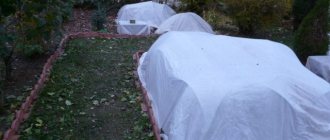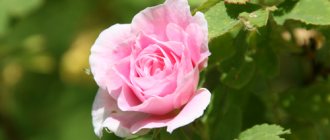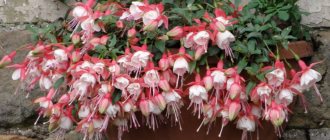Flower propagation
The Derby variety is propagated by layering and cuttings.
The choice is made in favor of the most convenient method. When should rose bushes be propagated? The optimal time for harvesting cuttings is June, and they take shoots without buds at the ends, 10-12 cm long. Layers are bent to the soil in early spring, but they can only be transplanted from the mother bush a year later.
A rose cutting starting to grow
Detailed description:
- The lower leaves of the cuttings are cut off, and the upper ones are shortened by half.
- The lower tip of the cutting is dipped in Kornevin, and then buried in loose soil. The top must be covered with a transparent cap to protect it from drying out.
- In fact, the cuttings are cared for for a year like young seedlings, only the established specimens being transplanted to a permanent place next summer.
Under the layering, holes 10 cm deep are dug next to the bush, where the branches are bent and covered with earth. Then you need to water them regularly for a whole year. If successful, each layer will produce an independent bush.
Reproduction methods
The hybrid rose variety Abraham Derby tolerates division well. Therefore, this option is most convenient for those who already have a similar plant. The bush is dug up, cleared of soil and cut into several parts. Each division is planted in a new place. This is the fastest and easiest way to grow another specimen in the garden.
Shoots on divisions need to be trimmed, leaving 12-15 cm from the root collar
Another effective option is cuttings. Separated shoots of roses take root and adapt well to nutritious soil. However, this process takes a long time.
Important! Cuttings are collected in spring or after flowering. They are rooted in a nutrient substrate and planted in open ground in the fall.
Abraham Derby roses can be propagated by layering or suckers. However, such methods are more labor-intensive and are better suited for experienced gardeners.
Growing rules
Since this variety is not designed for cultivation in the vast expanses of the Russian Federation, gardeners need to take care in advance to create certain conditions
To grow a proper and beautiful bush with a lot of flowers, it is important to be careful about planting
In what form is planting carried out?
It is possible to purchase varietal seedlings exclusively in a specialized nursery, where deliveries are made from European garden centers. The optimal age of planting material is 2-3 years. Such a bush is able to overwinter well and quickly adapt to a new place.
Seedlings with open or closed root systems are available for sale.
When purchasing, pay attention to the condition of the shoots and roots. The roots should not be overdried, and there should be no suspicious spots or signs of rot on the shoots
The living root does not crunch or break when bent. Some of the shoots may be woody, but the rest are covered with green bark.
Note! If you don’t want to limit yourself to exact planting dates, you should purchase a seedling with a closed root system in a container
Landing dates
The Abraham Derby rose variety can be planted both in spring and autumn. Spring seedlings take root better and give the novice gardener the opportunity to observe their development
It is important to get rid of excess buds on the plant before planting, leaving only 5-6. This will allow the bush to devote all its strength to vegetative growth and increase winter hardiness.
When planting, it is recommended to ensure good drainage in the holes and strictly follow the planting pattern. The plant grows both upward and to the sides, so the minimum distance between bushes should be 4 meters.
Selecting a location
The site must be selected carefully. It must meet the following requirements:
- good diffused lighting;
- protection from gusts of wind and drafts;
- elevated location.
A bush planted in a suitable place will bloom profusely.
If there are no hills on the site, it is recommended to raise the soil level by filling them yourself.
Criteria for choosing a seedling
The key to successful establishment of a rose is the correct choice of seedlings. It is recommended to give preference to two to three year old specimens. This is a period of high levels of winter hardiness and vigor, therefore the survival rate increases. It is preferable to choose green stems, without wrinkles or drying out.
How to prepare the soil and flower for planting
Before planting, the soil should first be dug well twice - six months before and 4-6 weeks before. Liming is not necessary, but it is recommended to add some organic matter.
When preparing a seedling, you need to cut the stems down to 4-6 buds, remove damaged and dry roots, and sprinkle the cuts with charcoal. After this, the plant is kept in water for 3-4 hours.
Step-by-step boarding procedure
After the preparation is completed, you can begin planting the rose. The sequence will be like this:
- In the selected area, dig a hole 2 shovels deep.
- Drainage is poured into the bottom of the hole, covering it with a layer of nutritious soil on top.
- The seedling is placed in a hole, deepening the root collar 5–6 cm below the ground level and carefully straightening the roots.
- The hole is covered with earth and pressed down with hands.
- The seedling is watered abundantly.
Note! It is advisable to mulch the space around the bush
Important Tips
- For better growth of the root system, seedlings must be soaked for at least 5-8 hours before planting. The roots in the water straighten well and are saturated with moisture, which improves the transfer of nutrients to the stem.
- Fungicides are added to the water. They prevent fungal diseases and prevent further development of infection.
- After soaking, the root system is thoroughly inspected. Sick, broken and damaged roots are cut off. The rest are pinched 2-3 cm to speed up the growth of the bush.
- The bush is placed in the central part of the hole, the roots are carefully distributed and covered with soil so that there are no voids left. The soil is compacted from above and watered abundantly. Even a small seedling requires at least 5-8 liters of water.
- Within a week, the bush can wither and weaken, so it needs moisture. To preserve it, the soil at the roots is sprinkled with mulch. Small sawdust, freshly cut grass, and hay are suitable.
Disease and pest control
One of the disadvantages of the variety is low resistance to diseases and pests. If the plant begins to wither or turn yellow, the buds do not open or fall off, emergency measures must be taken. How to protect a rose from rust, black spot and powdery rose, see the table below:
Table: Variety diseases, preventive measures and treatment methods
The English rose Abraham Derby suffers from spider mites, roseate sawfly, rosebud budworm, roseate aphid and thrips. To protect plants from pests, insecticides “Aktellik”, “Aktana”, “Iskra” or “Commander” are used.
Descriptions and photos of subvarieties
Next you can read the descriptions of the subvarieties and their photos.
Benjamin Britten
The variety is unpretentious and disease resistant. The height of the bush is up to 1 m. The buds are cup-shaped. The flowers are lush, rosette-shaped, red in color.
William Shakespeare
It differs in the duration of flowering. The bush is tall, up to 1.5 m in height. Stems are erect. The flowers are purple.
The variety is winter-hardy. The bush is lush, up to 1.5 m high. The flowers are double, rich yellow, the edges of the petals are pale yellow.
When and how?
It blooms in early summer, flowering continues until mid-September. The flowers are double in structure, large, up to 12 – 14 cm in diameter. The center of the flower is apricot color, the edges of the petals are pink. Petals are wide, up to 70 pcs. The variety has a persistent, rich fruity aroma.
Care before and after
To stimulate flowering, phosphorus fertilizers should be added to the soil. Water abundantly before and during flowering. During flowering, the plant should be fed with a solution of potassium sulfate. Withered flowers and buds are removed from the bush immediately. Before wintering, all leaves and unopened buds must be torn off.
What to do if it doesn't bloom?
Perhaps the bushes do not have enough light, in shady places the stems stretch out and buds do not form. It is necessary to examine the bushes for the presence of garden pests and viral infections that slow down flowering.
Rose blossom
Rose Olivia Rose - description of varietal shrub
With the right agricultural technology, the Abraham Derby rose will delight you with its magnificent flowers for decades in a row throughout the summer months. At the height of flowering, the aroma of blossoming buds can be clearly heard from a distance of several meters.
- Period of activity and rest
The first flowers open in the first ten days of June. The last of them can be cut off in the last ten days of September.
- Care during and after flowering
To ensure flowering does not stop, it is important not to skip feeding, and be sure to cut off wilted buds, preventing the plant from wasting energy on ripening the seeds.
- What to do if it doesn’t bloom, possible reasons
This effect occurs when planting roses in the shade. If the bush has changed the color of the foliage to yellow-brown, then this indicates an acute lack of iron and magnesium, and urgent feeding is required.
Where to plant a rose
This rose, alas, was not intended to be suitable for growing in our latitudes, so to achieve the best results you should adhere to a few simple rules.
Lighting and terrain
The Austin rose "Abraham Derby" does not tolerate shade at all, so the best place to plant it would be a place under constant sunlight.
This flower is extremely unstable to wind and drafts, under the influence of which its petals and buds begin to fall off, and therefore the planting site must be well protected from them on all sides.
Did you know? Rosehips, which are a wild variety of rose, contain more vitamin C than citrus fruits, which makes decoctions from it an excellent remedy for the treatment and prevention of various diseases.
In addition, the place where planting will take place should not be excessively wet or low-lying, since excess moisture can cause significant damage to the roots of the plant.
It is not recommended to plant in areas where the same crop was previously grown, since characteristic pests and pathogens could remain in the soil.
Soil type
Almost any soil is suitable for this type of rose, it is only desirable that it be developed. It is possible to further improve the soil by digging it up and then loosening it. If the soil is too sandy, you can add a small amount of humus to it. Additional liming of the soil before planting is usually not critical.
Advantages and disadvantages of the variety
Rose Abraham Derby has both positive and negative characteristics, which we will consider below.
Advantages:
- refined and at the same time extravagant appearance of the bush;
- extraordinary color of buds;
- application in home gardening and urban landscapes;
- interesting aroma;
- long flowering period.
Flaws:
- high requirements for growing location and lighting;
- poor winter hardiness;
- low disease resistance;
- deterioration of decorative effect under the influence of sunlight or rain.
Landing Features
The rose can be planted as separate bushes or a support can be built for it. When grown for a long time in one favorable place, roses on a support can reach 300 cm in length.
In order for the root system to take root well, it is necessary to dig a deep hole up to 50 cm in length. The width of the pit is at least 70 cm. A drainage layer is made at the bottom with expanded clay, finely crushed brick or sand. To provide the bush with nutrients during rooting, humus or a special soil mixture is added to the hole. To stabilize the acidity of the soil, add 2 cups of wood ash.
Novice gardeners often complain about poor flowering of Abraham Derby. The reason lies in low-quality planting material. It is recommended to purchase rose cuttings of this variety only in specialized stores. The seedling must be at least 2 years old. By this period, the future bush has already developed winter hardiness. After planting, this material takes root well. By this time the stems become woody, but remain fresh.
You can recognize a seedling disease by its drooping appearance, yellowness of the stem and wrinkling. Planting material obtained by grafting has the best flowering.
Important Tips
- For better growth of the root system, seedlings must be soaked for at least 5-8 hours before planting. The roots in the water straighten well and are saturated with moisture, which improves the transfer of nutrients to the stem.
- Fungicides are added to the water. They prevent fungal diseases and prevent further development of infection.
- After soaking, the root system is thoroughly inspected. Sick, broken and damaged roots are cut off. The rest are pinched 2-3 cm to speed up the growth of the bush.
- The bush is placed in the central part of the hole, the roots are carefully distributed and covered with soil so that there are no voids left. The soil is compacted from above and watered abundantly. Even a small seedling requires at least 5-8 liters of water.
- Within a week, the bush can wither and weaken, so it needs moisture. To preserve it, the soil at the roots is sprinkled with mulch. Small sawdust, freshly cut grass, and hay are suitable.
With proper care, the bushes bloom beautifully. To make flowering more abundant, fading flowers are carefully picked off. Three days after each watering, the ground around the bush is thoroughly loosened and weeds are removed.
Fertilizer application
Spring feeding. It is carried out immediately after circumcision or when the buds are swollen. Mullein or special fertilizer for roses is placed around the perimeter of the bush, 10-15 cm thick. During the bud formation stage, the bush can be fed with rotted grass.
Summer feeding. It is carried out after the first flowering, but no later than July 20. Complex fertilizers will help maintain the vigor of the bush. Nitroammophosphate contains three important components - potassium, phosphorus and nitrogen. For one bush, 75 grams of the substance is enough.
Autumn feeding. In early September, the last fertilizing is carried out before winter.
During this period, it is important to enrich the soil with potassium. Up to 15 grams of substance are scattered per meter
Be sure to stabilize the acidity of the soil with wood ash (1-2 cups). Before filling under the root, the ash must be sifted.
Fertilizers are not applied to cooled soil. At this time, the root system of roses is preparing for winter, and the processes of nutrient absorption are significantly suspended.
Preparing for winter
For the winter, the variety must be insulated. When a steady cold snap sets in, a shelter is built over the rose bushes. First, the plant is covered with sand or dry grass. The use of straw or peat is excluded, since these materials quickly absorb moisture: the bushes simply dry out. Before frost sets in, shoots that are too long or thin should be pruned. And also in late autumn all foliage is removed.
As soon as stable cold weather sets in, roses are wrapped in any covering material. You can build a frame from sticks or iron rods and put suitable material on it.
The beautiful “Abraham Derby” will certainly become a real decoration of your garden. The variety blooms for a long time, and the buds exude a delicate aroma. By following fairly simple agricultural techniques, growing strong and brightly flowering bushes is not particularly difficult.
Proper planting of seedlings
The key to successful and productive growth is the correct and timely planting of seedlings. The overall process is fairly straightforward and is similar to planting almost any bushy plant.
Rose amazes flower growers not only with its beauty, but also with its variety of varieties. You can decorate your flower garden with the following varieties: Sophia Loren, Falstaff, Pierre de Ronsard, Pink Intuition, Blue Perfume, Graham Thomas, Mary Rose.
Criterias of choice
It is recommended to purchase seedlings whose age does not exceed 2-3 years, since it is these seedlings that have the greatest winter hardiness and vitality, and therefore have the highest survival rate after planting.
When purchasing, you need to pay attention to the condition of the stems. Several of them should have a woody structure, and the rest should have a green, fresh appearance.
Wrinkling and drooping of young stems may be evidence of drying out of the seedling or the presence of possible diseases.
As a rule, there are two types of seedlings on sale: on their own roots and grafted. The former are usually weaker in their development, so before purchasing, be sure to ask the seller what type of product he is offering.
Planting dates and scheme
Planting roses is possible in two periods - spring and autumn. The first period is better suited for beginners, since planting at this time allows the seedling to develop better and, as a result, better survive the winter. However, experienced gardeners recommend planting in the fall; in this case, it is necessary to correctly guess the weather and time.
Before planting, the seedling should be trimmed, leaving 4-6 buds, since too many buds can weaken the vegetative growth of the plant during the summer period, which will lead to the inevitable death of the plant during wintering. The roots also need to be trimmed, removing the damaged parts and lightly trimming the remaining ones. Thanks to this treatment, the bush will acquire a more powerful and branched root system.
Before planting, a hole 1.5-2 shovels deep is dug, at the bottom of which some kind of drainage and a small layer of fertile soil, or a nutrient mixture consisting of peat, sand and humus are placed. Next, the seedling is placed in the hole so that all its roots are straightened. After this, the hole with the seedling inside is filled with earth, which should be compacted a little at the very end.
Important! The root collar of the plant should be located deep in the soil at a distance of 5-6 cm. Next, you should mulch the soil around the young bush with freshly cut grass or hay and water the plant thoroughly
Next, you should mulch the soil around the young bush with freshly cut grass or hay and water the plant thoroughly.
Features of the plant
A dense, powerful, fast-growing, well-leafed bush of a rounded shape, reaches a height of 1-1.5 m with a width of up to 1.2 m. If you form it as a climber, then under favorable conditions and the presence of support it will be long, thin, flexible and fairly strong shoots can stretch up to 3 m. The leaves are medium in size, the leaf blade is glossy, rich bright green, dense, leathery.
Bloom
Bushes of the Abraham Derby variety are among the first to bloom, in May - June. It is distinguished by repeated, almost continuous and abundant flowering throughout the season, lasting until September. The flowers are arranged singly or collected in compact inflorescences-tassels, consisting of 2-3 pieces.
Large goblet-shaped buds of apricot color open into densely double cup-shaped flowers with a diameter of 12-14 cm, numbering up to 140 petals, painted in delicate pastel pink-peach tones.
The flower repeats the classic shape of an ancient rose, but is larger in size and has a rich aroma.
The color of flowers changes depending on external conditions: in cool, cloudy weather, bicolor appears more clearly - they are soft pink with soft yellow in depth, and with increasing temperature there is a predominance of more monochromatic apricot-cream shades. The petals are very delicate, satiny, pink at the base, with a golden-white underside and lightened edges. The inner petals are darker, the outer petals fade to pale pink. Flowers of the Abraham Derby variety are distinguished by a very strong, pronounced fruity-strawberry aroma with notes of rose oil and citrus.
Under the weight of the flowers, the shoots may droop, so it is advisable to strengthen them on a support. During prolonged rains, the petals often stick together, when they bloom, they do not fall off for a long time, sometimes they turn brown and dry out right on the bush. In such situations, experienced rose growers advise pruning flowers that have lost their decorative effect, so as not to overload the plant.
Rose Abraham Darby - what kind of variety is it?
The variety was obtained in 1965 by crossing two varieties:
- polyanthus yellow rose Yellow Cushion;
- climbing pink-red rose Aloha.
Rose Abraham Darby
The resulting result went on sale under several names in addition to Abraham Derby: AUScot, Candy Rain, Country Darby.
Brief description, characteristics
The double flower of 70 petals has a classic cup-shaped shape for old park roses. The petals are colored copper-apricot in the central part of the corolla, and pink closer to the edges. A powerful bush with a height of 1.2 to 3.05 m can be pruned into a compact and rounded bush, up to 1.5 m in diameter. Or you can give it the appearance of a climbing rose. But in any case, the rose bush will be strewn with flowers.
The foliage is abundant, green, shiny. Flowering occurs in alternating long waves.
Blooming flowers droop under their own weight
Rose corollas are changeable in color. In the heat, their shade becomes apricot, and in cool weather it turns into a rich pink. Shedding is reluctant. Among English roses, Abraham Derby is considered the largest; its buds in full bloom reach 15 cm in diameter.
Forcing occurs at the ends of annual shoots in clusters of 1-3 flowers. The strongest aroma has typical rose, strawberry and fruity notes.
Note! The prickliness of this variety is medium. Therefore, when caring for a rose bush, it is advisable to wear gloves made of thick material.
Advantages and disadvantages of the variety
The advantages of Abraham Derby are considered:
- Spectacular view of flowering bushes.
- Continuous long flowering.
- The unusual size of the flowers.
- Strong persistent aroma.
Among the disadvantages, it is worth noting average resistance to diseases, low frost resistance, the ability to fade in the heat, as well as deterioration in flowering during flooding, drought and in the shade.
Use in landscape design
The Abraham Derby variety is more often referred to as a scrub because the bushes are vigorous. But in reality, the rose is often planted near supports in order to let its vines spread along the trellis.
With this solution, it is much more advantageous to show the beauty of flowers, which often droop under their own weight. When creating mixborders, bushes are planted in the background.
Abraham Derby bush in the garden
Planting dates and scheme
Planting roses is recommended in two periods - autumn or spring. In the second case, the seedling has time to take root and gain strength over the summer, which will make the work easier for beginners and novice gardeners
However, experienced gardeners advise planting seedlings in the fall, but in this case it is important to choose a day suitable for weather conditions
Before planting, the branches are cut to 6 buds, since a large number of them weakens the plant. The roots are also trimmed, removing damaged and too long ones. This way the bush forms a powerful root system.
A hole for planting is dug to a depth of 1.5 shovels, and drainage must be placed at the bottom. Crushed red brick is best suited for these purposes. Then a layer of humus, a little sand and peat are poured into the hole.
The seedling is placed in the hole, the roots are well straightened and carefully sprinkled with earth, compacted around the bush and watered well, ending the planting activities at this stage. The soil is mulched with mowed grass or hay.
Watch this video on YouTube
Description of the variety and features of the park rose
The English park rose was first grown in 1965. "Abraham Derby" is the result of crossing polyanthus and climbing plant species. The buds are pale, pinkish in color, turning yellowish. The presented rose has one peculiarity - depending on weather conditions, its petals can change their color to peach.
The bushes are impressive in size and can reach 1.5 meters in height. With good care and proper maintenance conditions, the height of the bushes reaches even more than 2 meters.
Since the variety grows quite quickly, it can also be planted as a climbing rose. The flowers are double, reaching up to 14 cm in diameter. "Abraham Derby" blooms from early summer to mid-autumn, which is the main advantage of the species. The flowers have a light lemon scent.
Watch this video on YouTube
Planting and care
In order for the plant to delight with its beauty for as long as possible, it must be correctly placed in the garden plot, taking into account all the preferences of this species:
- You should not plant shrubs in a draft; it is best to choose a sunny place protected from the wind;
- The plant should not be placed in low-lying areas where precipitation and melted snow accumulate;
- It is also better not to plant where the same crop previously grew, because pests and pathogens can move onto it.
Experienced gardeners recommend purchasing seedlings only from trusted nurseries that sell high-quality planting material.
The size of the hole for bushes is on average 70 centimeters in depth and width. At the bottom it is necessary to make drainage from expanded clay or other available means, then add a soil mixture consisting of:
- 3 parts humus or rotted manure;
- 1 part sand;
- 2 parts of fertile (top) layer of soil;
- 200 grams of complex fertilizers for roses;
- 400 grams of wood ash.
Before planting the Abraham Derby seedling, it must be soaked in water.
Before planting, the seedling needs to be prepared, namely, soaked in water for several hours, remove all damaged roots and lightly trim the main ones. This procedure will stimulate the plant to grow and take root as quickly as possible.
During planting, the bush is placed on a previously prepared mound and carefully sprinkled with earth. After all work is completed, the rose is watered and mulched.
Watering
Proper care of a rose consists primarily of frequent and timely watering. To form a powerful and branched root system, the plant is watered once a week, using 10-15 liters of water. If you neglect this procedure, the roots of the bush will rise to the top and can easily be damaged. Watering stops at the beginning of autumn.
In order for the bush to receive the required amount of oxygen, the soil around it is regularly cleared of weeds and loosened.
Top dressing
Fertilizers begin to be applied from the 2nd year of the plant’s life, using the following scheme:
| Period | Fertilizer |
| In early spring, immediately after the snow melts | Bird droppings in the proportion of 1d20 or cow manure in the proportion of 1d10 |
| With the appearance of the first buds and until the end of flowering, every 2-3 weeks | Complex mineral fertilizers for roses |
| End of August | The rose is treated with potassium sulfate |
It is best to fertilize the plant in the evening, immediately after watering.
Pruning rules
Abraham Derby bush pruning scheme
Depending on the purpose of use, a rose of this variety requires different types of pruning:
- Climbing plants can be left intact and only damaged branches removed;
- To obtain a lush bush, the tips of the vines are slightly trimmed at the beginning of each season;
- If the bush should look neat and compact, all shoots are cut by 2/3.
All work is carried out in early spring, and the cutting angle should be 45 degrees.
Rose bush care
The agricultural technology for growing park roses is generally standard. To get beautiful flowers, you should protect them from diseases and pests, feed and water them on time.
Watering rules and humidity
Rose Koko Loko - description of a varietal flower
The desired frequency of watering is every week. If it rains often enough, you may not need to water at all.
The optimal water consumption is 10-12 liters for each bush. In the fall, regardless of the weather, watering is stopped. Young shoots should not grow back with the arrival of September.
Fertilizing and soil quality
In the first year after planting, you can do without fertilizing. The prepared substrate contains everything necessary for active growth.
In subsequent years, the entire feeding season is carried out at intervals of 2 weeks. Specialized complex fertilizers are suitable, for example, “Agricola for roses”, superphosphate, as well as organic compounds - humate, mullein. The soil should be well loosened and free of weeds.
Pruning and replanting
When the cover is removed from roses in the spring, it is necessary to do sanitary pruning. To obtain a compact bush, the shoots are shortened by two thirds. To form a tall and spreading bush, only diseased and damaged branches are pruned, and healthy ones are lifted and tied to a trellis.
Since the depth of the root system can reach 2 m or more, replanting adult roses is not recommended. They do this only in a hopeless situation. The plant will be sick after this for at least 2-3 years, and there is a high risk of death.
Features of wintering a flower
When performing covering measures, Derby rose has winter hardiness down to -29 ° C (zone IV). With the arrival of frost, the bushes are hilled, cutting out excess (immature, twisted, diseased) shoots. For hilling, mix dry soil with sand.
Attention! Peat and straw are not suitable for winter hilling, as they become saturated with moisture and can provoke the appearance of fungal diseases.
Climbing bushes are bent to the ground (untied from the supports), covered with agrotextiles or spruce branches so that in winter the snow accumulates on top in a snowdrift. Low young roses can be covered with ordinary cardboard boxes, weighing them down with a weight to prevent them from being blown away by the wind. Remove the covers after the soil has completely thawed.
Soil preparation and proper planting
Unfortunately, the variety is not suitable for growing in the middle zone, therefore, in order to achieve lush flowering, simple recommendations should be followed.
This climbing rose does not like shade very much, and therefore it is advisable to choose the most sunny area for planting it, well protected from drafts. You cannot plant seedlings in lowlands, in flower beds where other types of roses grew.
If we talk about soil preferences, then the presented variety is completely unpretentious in this regard and can grow well on any soil. If the soil is sandy, humus should be added to the hole prepared for the rose. The key to proper growth of a future beauty is proper planting.
Watch this video on YouTube
To do this, you need to choose seedlings no older than 3 years old that have the greatest frost resistance and strength.
When purchasing, pay attention to the branches and roots, which should be fresh, without signs of disease.
Selection of seedlings and planting
When purchasing seedlings, you do not need to choose those that grew on their own root system - they do not take root well. Preference should be given to grafted bushes. You can ask the salesperson at the store.
Healthy plants have juicy and fresh green stems, in some cases partially woody (central shoot). Limp and wrinkled bushes indicate the presence of diseases.
Beginning gardeners are recommended to plant in the spring so that the seedling can take root during the summer and survive the winter. Experienced rose growers already know the specifics of choosing the necessary conditions, so they can safely plant bushes in the autumn.
Planting roses is done as follows:
- Before planting, the plants are pruned; about 5 buds should be left on them - this amount is optimal for the normal development of the bush. If there are more buds on the plant, it may weaken and wither. The roots are pruned: healthy ones are cut by 2-3 cm, and dry and deformed ones are removed completely - this pruning helps stimulate the development of a strong root system.
- The bushes are placed in a container with water for 4 hours.
- The planting hole must have sufficient width and depth so that the root system can expand well. A drainage layer (stones, pebbles, broken bricks) is laid at the bottom, and nutritious soil, which consists of humus, peat and sand, is poured on top. You can also add special baits for roses to this composition, taking into account the instructions.
- The bush is placed in a hole, deepening the root collar 6-8 cm into the ground. The top layer of earth is slightly compacted.
- The soil around the rose is mulched with sawdust, straw or mown grass - this will promote the development of the plant. Mulch will provide the root system with the required level of acidity and the required amount of moisture, protect it from frost and prevent the spread of weeds.
- The soil around the bush must be watered abundantly.
Preparing for winter
As winter approaches, you need to carefully take care of preparing the plant for the cold. First you need to hill up the root zone of the rose. Sand and earth are used for this. Peat should not be used, because it can create a greenhouse effect and the roots of the plant will rot over the winter. The stems need to be trimmed and all remaining foliage removed.
To properly prepare for hibernation, the bush should begin to limit watering from mid-August. Watering is halved and completely stopped in September. Before the onset of cold weather, you need to carry out two more feedings of the roots. Superphosphate, potassium and boric acid are suitable for this.
Be sure to create a convenient frame for the covering material. You can build it yourself or buy it at a garden store. Most often, such frames are metal arches in the form of tunnels, which remain throughout the summer. The following are often used as covering materials:
- rags or burlap, which is not very convenient, but effective;
- spunbond, agrofibre - they allow moisture to pass through and will last a very long time;
- polyethylene film is a cheap material, but it does not allow air to pass through, so you will have to make small holes in it.
Growing problems
Rose Abraham Darby does not tolerate rainy and hot weather. During rain, flowers may not bloom, and in hot weather, blooming buds decrease in size and fade. In intense heat, the petals completely fall off.
Another disadvantage of the variety is its poor resistance to diseases. Roses are easily susceptible to fungal infections such as:
- Black spotting, the signs of which are white or purple spots turning into black tubercles. If the plant becomes infected, all diseased parts are removed and burned. For prevention, spraying with special preparations Immunocytophyte, Amulet, Elem is carried out.
- Powdery mildew. When infected, the foliage changes shape and a white coating forms on it. If signs of disease are noticed, the plant should be treated with Topaz or Forecast. For preventive purposes, at the beginning of the spring season, the bush is treated with copper sulfate.
- Rust damages stems and foliage. Orange formations appear on the leaves, the shell cracks on the stems and orange dust appears. It is almost impossible to cure a diseased plant; the rose is completely removed. For preventive purposes, the bush is treated with a solution of copper sulfate and slaked lime.
Description and history of selection
This rose was first obtained in 1965 by crossing two modern varieties - the polyanthus rose with yellow petals, “Yellow Cushion” and the red-pink double climbing rose variety “Aloha”.
Did you know? Natural rose oil is one of the most expensive and valuable in the world. Its price exceeds the cost of gold and platinum. To obtain one liter of such oil, about three tons of fresh petals are needed.
When the flowers of this variety bloom, they take on the classic shape characteristic of all bush roses. The buds have a soft pink color closer to the center and a slightly yellowish tint closer to the periphery. One of the characteristic and unusual features of this flower is the dependence of color on environmental conditions. The buds, like chameleons, are able to change their color - from pink with a slight touch of yellow around the edges to peach.
The bush is distinguished by its rather large size (up to 1.5 meters in height), splendor and roundness. With careful care and favorable environmental conditions, it can reach a height of up to 2.5 meters. Learn more about the intricacies of planting and caring for English, Canadian and Dutch roses.
Origin of the variety
The variety was bred in 1985 by the famous breeder David Austin in the UK and registered under the name AUScot. The flower received the name “Abraham Derby” in honor of the English industrialist, designer and metallurgist, creator of the metal bridge, which is located a few kilometers from the David Austin family nursery.
Abraham Darby was the result of crossing two modern roses: the floribunda Yellow Cushion and the climbing Aloha, which in itself is unique, since David Austin uses mainly old garden varieties in his breeding work.
Modern varieties were used as parent forms: Yellow Cushion (pictured left) and Aloha (right)
The exceptional qualities and worldwide popularity of Abraham Darby are confirmed by numerous awards received at international competitions: in 1999 in Salem, Modesto, Los Angeles and Las Vegas, in 2000 in Harrisburg, and in 2001 in Millenn and Augusta (USA).
Use in landscape design
Abraham Derby roses often form tall thickets, are used as hedges, and are planted along borders. The variety looks good in group plantings with coniferous and evergreen shrubs. Tall bushes harmonize with phlox, aconite, and sage. In flower beds and flower beds it is recommended to plant in the background, against the backdrop of tulips, hyacinths, and peonies.
Rose Abraham Derby does not tolerate bright, direct sunlight.
Bushes should be planted on the east and west sides of the house. From the midday sun on the south side, spots may appear on the leaves - burns, flowers lose their brightness, and burn out.
It should be noted that daylight for this variety should be at least 5–6 hours per day.
Strong gusts of wind and drafts cause buds and petals to fall off; the planting site should be protected and quiet on all sides.
The litter is not picky when choosing soil. The main condition is fertility and permeability. Rotted manure, compost or manure should be added to the soil. Part of the turf soil is added to sandy soils. Regular loosening of the soil and removal of weeds.
In warm climates, seeds are sown directly in open ground in mid-autumn.
- A shallow trench is dug.
- The seeds are evenly distributed.
- The sowing is moistened and sprinkled with substrate (sand, peat, garden soil in equal proportions).
- The top of the crop is covered with leaves and coniferous spruce branches.
- In winter, a frame is formed and covering material is fixed on top.
- In spring the cover is removed.
- Grown seedlings are transplanted to a permanent place.
You can grow seedlings in a greenhouse:
- First, the seeds are soaked in a solution of potassium permanganate for 2 hours. The seeds are sown in small containers.
- The sowing is covered with film and ventilated daily.
- Content temperature – 20 – 22 °C. The lighting is bright, watering is regular, in small doses.
- The seedlings, after a month, must be moved to the basement. Air temperature – 8 °C.
- In spring, seedlings are transplanted into open ground.
Temperature
Rose Abraham Derby overwinters in open ground with shelter and can tolerate temperatures down to – 10 – 12 °C. The optimal air temperature for this variety is 20 – 25 °C. Does not tolerate heat well - flowers become smaller, fade, and petals may fall off.
Excessive soil dampness is unacceptable. Watering is moderate. Between waterings, the soil should dry out by 2 cm. Watering should be done early in the morning or in the evening, after sunset. Irrigation method is sprinkling. Adult bushes require up to 10 liters of water, young seedlings are watered with less volume. It is recommended to use clean, settled, warm water. In autumn, watering is reduced. In winter, the bushes are not watered.
There is no need to fertilize the soil within a year after planting; the plant has enough nutrients.
In spring, nitrogen fertilizing is required to increase the green mass of the bush. During the formation of buds, it is necessary to fertilize the soil with complex fertilizers for roses.
At the end of summer, it is recommended to feed the bushes with potassium fertilizers. Feeding should be alternated. It is recommended to add bird droppings (1:20), liquid mullein (1:10). Only manure that has fermented for 7 to 10 days is used.
Fertilizers are applied in the evening. The soil is well moistened beforehand.
Pruning is carried out in the spring and before wintering. To form a compact bush, the stems are cut to 40–50 cm. If the stems are located on climbing supports, only the tops of the shoots are cut off in the fall. Stems frozen over the winter are removed. During transplantation, dry and damaged root shoots and unripe stems are cut off.
Transplantation is carried out in spring or autumn. Young seedlings and mature bushes with strong growth are replanted.
- The mother bush or seedling is cleared of soil.
- The tops of the stems and long shoots of the root are cut off.
- The cut sites are disinfected.
- The root is soaked in warm water for 7 hours.
- A bush is placed vertically in a hole with a diameter and depth of up to 50 cm.
- The hole is filled with soil, the bush is well moistened.
- After subsidence, soil is added to the tree trunk circle.
Soil for replanting: a mixture of sand, peat, humus in equal proportions.
Preparing for winter
In autumn, the shoots should ripen well; it is advisable for the flowers to fall off on their own, without pruning. At the end of November, leaves, flowers and shoots are pruned and removed.
In southern latitudes, shelter is required when temperatures drop to -10°C.
- Before covering, the soil must be hilled up.
- A frame made of plywood, foam plastic, etc. is built around the bush.
- The bush is sprinkled with leaves, shavings, spruce branches, and dry humus.
- When it gets cold, roofing material and film are laid on top of the frame.
For air ventilation, it is necessary to make small holes at the base of the shelter.
The top cover is removed in the spring, at 0°C.
Reproduction
By layering
The side shoot is bent to the soil, secured with a wooden slingshot and dug in. Regular watering is required until rooting. In the spring, the seedling is separated and transplanted to a permanent place.
Cuttings
At the very beginning of flowering, semi-lignified cuttings up to 10 cm long are cut off. The lower leaves are torn off from the cuttings.
Important: the cut is made at an angle of 45°, 0.5 cm below the bud.
The cuttings are buried in special soil and covered with film. The seedlings overwinter in greenhouse conditions, in a bright place at room temperature. Planting of seedlings in open soil is carried out every other year, in the spring.
Planting and growing procedure
When choosing a place to plant the specified rose variety, the following factors should be taken into account:
- The seedling must be planted in a sunny place.
- The root system of plants does not tolerate excess moisture, so it is necessary to look for a place that is not flooded by melt water.
- You will need to find a place protected from winds and drafts. These factors negatively affect the plant.
- You cannot plant a seedling in soil where identical plant varieties previously grew. This is due to the fact that various parasites and fungal infections can remain in it.
- The soil must first be prepared. It consists of eliminating weeds, loosening the soil and applying the necessary fertilizers.
Directly to introduce the seedling into the soil, you will need to dig a hole. It is made in the shape of a square with sides of seventy centimeters. You will need to select soil two and a half shovels deep.
Before introducing the seedling into the soil, it is necessary to soak the root system for several hours. This will speed up the development of the bush. It is also necessary to remove weakened or broken roots, and slightly trim the main part of the rhizome.
Subsequently, the seedling is brought into the prepared hole, the root system is straightened and gradually covered with soil. After this, it is necessary to water the bush abundantly and carry out further care.











